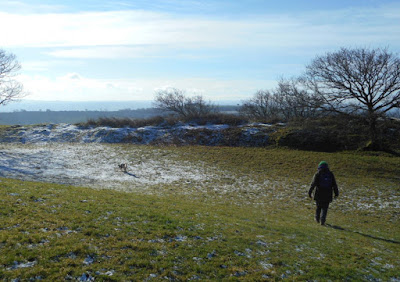I’d done some research and discovered that ‘hill forts’ are Iron Age villages protected by ditches and banks, but I didn’t hold out much hope for this one as any I’d seen before were hidden in undergrowth and more imaginary than real.
Tuesday 26 January 2021
A day of magic
I’d done some research and discovered that ‘hill forts’ are Iron Age villages protected by ditches and banks, but I didn’t hold out much hope for this one as any I’d seen before were hidden in undergrowth and more imaginary than real.
Tuesday 19 January 2021
New moon, new broom
Tuesday 12 January 2021
Nature washing over you
Oh dear, here’s one of those signs that make me see red. It’s children I worry about. Do they ever get the chance to be out in the countryside by themselves, to explore and play and use their imaginations?
 |
| The unwelcoming sign |
 |
| Lovely views |
And there’s plenty of woodland here accessible from the path.
 |
| Accessible woodland |
Oh dear. Here’s a new fence.
 |
| A new fence |
And what about this? I call this sort of footpath a ‘gulag’. (The bridge is for the animals.)
 |
| The gulag |
 |
| The watermeadows |
 |
| Negotiating the mud |
Two days ago
It’s Sunday and lockdown and people stream round the lanes and paths which I’ve had to myself for four decades. I don’t know where they all come from but I suspect Exeter, whose new housing estates are spreading our way, and from a new town which has sprung up a few miles to the east of us.
Nevertheless I’m charmed by a clump of gorse in flower as ever, some bedraggled left-over red campion and some toadstools projecting horizontally from the hedgebank. What on earth are they? They look like felted drumsticks.
 |
| Red campion |
 |
| What are these toadstools? |
Now we have to cross the stream, well churned by cattle. Ellie charges through, splashing mud up our trousers. Frog treads warily. He’s wearing walking boots which reach only to his ankles. I’m wearing wellies so I wade over, trying each foot before putting my weight on it, remembering a time when I sank into quick-mud and had to abandon a wellie, throw myself forwards and crawl out (then walk home filthy and one-booted).
We wonder about the green pimples all over the grass.
‘Perhaps they’re fairy houses,’ I say whimsically.
‘Maybe,’ says Frog. ‘I did think I saw a door in one.’
I suddenly feel terribly excited. ‘Where?’
It turns out to be a leaf.
We have a choice of routes, but there’s not much in it. Each is as muddy as the other.
 |
| The unmetalled road |
 |
| The bridleway (right) |
We descend to a hamlet, so damp and deep that the lichen on the trimmed hedge looks like a forest of miniature Christmas trees.
My back’s beginning to ache so we rest at the gateway to a farm. Two muscular collies charge out barking, look us over, and then wander off, having decided that we’re OK. I feel honoured.











































